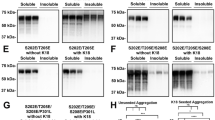Abstract.
The calcium-activated protease calpain cleaves a variety of biologically important proteins and serves, therefore, as a key regulator of many cellular functions. Activation of both main isoforms, calpain 1 and calpain 2, was demonstrated previously in Alzheimer's disease. In this report, antibodies specifically recognizing the active form of calpain 2 were used to investigate calpain 2 activation in a broad range of neurodegenerative diseases, utilizing multiple-label confocal immunofluorescence imaging. With rare exceptions, the active form of calpain 2 was found in colocalization with hyperphosphorylated tau protein. Aggregates of mutated huntingtin, α-synuclein, or unidentified protein in motor neuron disease type of frontotemporal dementia were always negative. These findings indicate that calpain 2 activation is not a general response to protein aggregation. In tauopathies, more pathological inclusions were labeled for hyperphosphorylated tau than for activated calpain 2. The extent of colocalization varied in both a disease-specific and cell-type specific manner. The active form of calpain 2 was detected in 50–75% of tau neurofibrillary pathology in Alzheimer's disease, Alzheimer neurofibrillary changes and Down's syndrome, as well as in the accompanying Alzheimer-type tau pathology in diffuse Lewy bodies disease, progressive supranuclear palsy, and corticobasal degeneration. For glial cells, only 10–25% of tuft-shaped astrocytes, glial plaques, or coiled bodies contained activated calpain 2. The majority of Pick bodies were negative. The association of calpain 2 activation with hyperphosphorylated tau might be the result of an attempt by the calpain proteolytic system to degrade the tau protein aggregates. Alternatively, calpain 2 could be directly involved in tau hyperphosphorylation by modulating protein kinase activities. Overall, these results provide evidence of the important role of the calpain proteolytic system in the pathogenesis of neurodegenerative diseases with tau neurofibrillary pathology.
Similar content being viewed by others
Author information
Authors and Affiliations
Additional information
Electronic Publication
Rights and permissions
About this article
Cite this article
Adamec, E., Mohan, P., Vonsattel, J.P. et al. Calpain activation in neurodegenerative diseases: confocal immunofluorescence study with antibodies specifically recognizing the active form of calpain 2. Acta Neuropathol 104, 92–104 (2002). https://doi.org/10.1007/s00401-002-0528-6
Received:
Revised:
Accepted:
Published:
Issue Date:
DOI: https://doi.org/10.1007/s00401-002-0528-6




